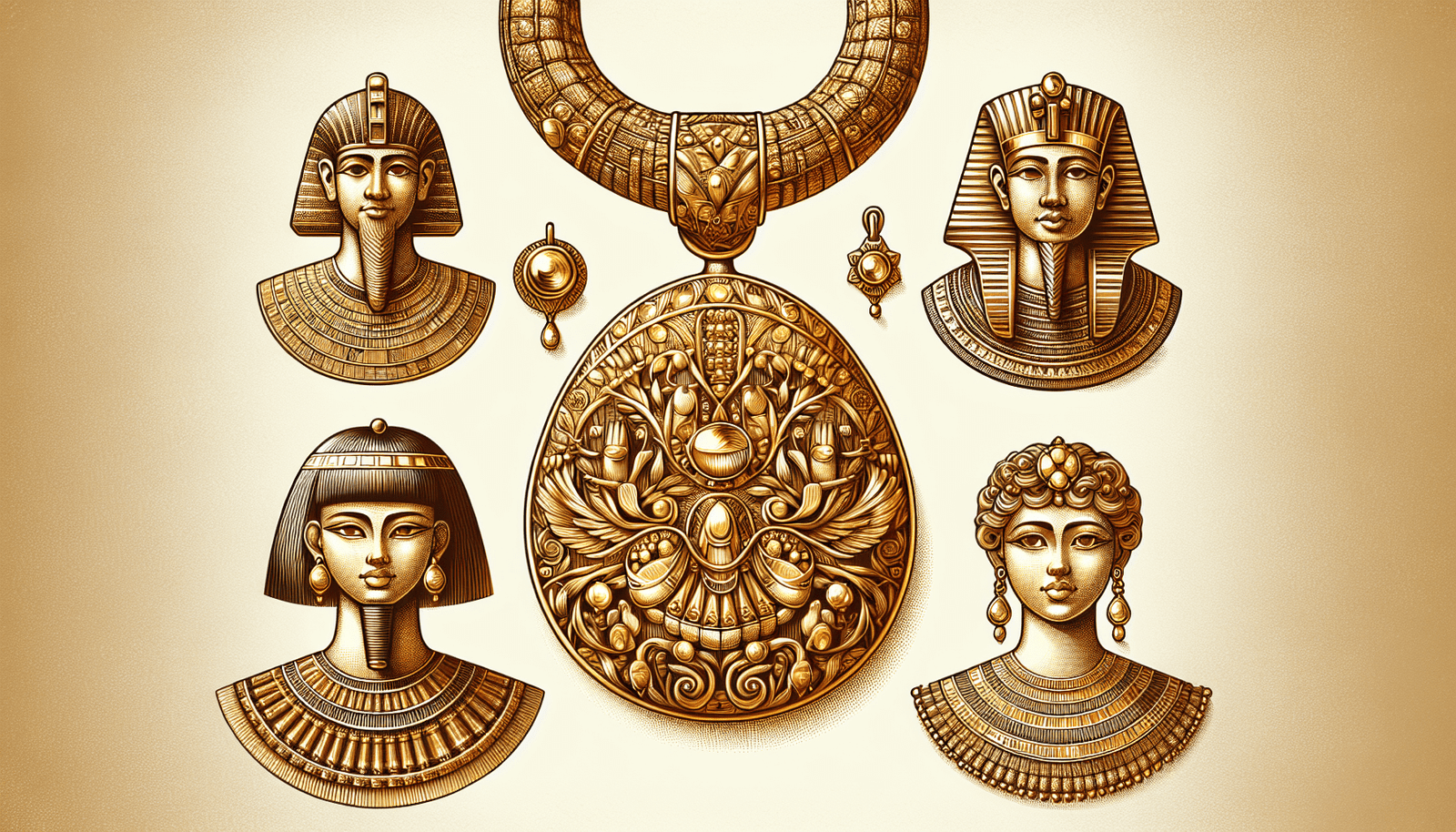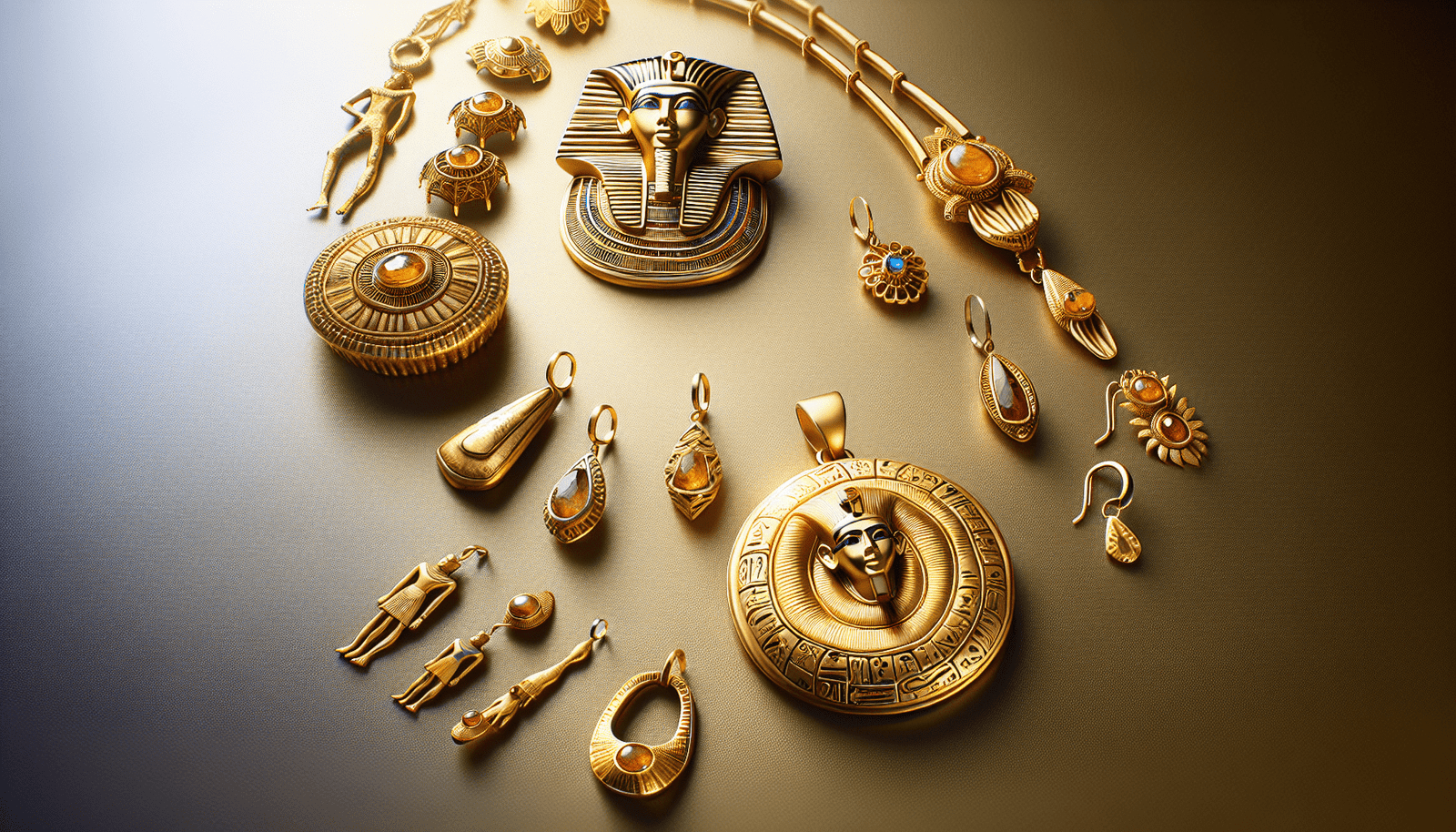Have you ever wondered how gold jewelry has changed and evolved over different eras? From ancient civilizations to modern-day trends, the history of gold jewelry is truly fascinating. Let’s take a journey through time and explore the evolution of gold jewelry across eras.

Ancient Civilizations: The Beginnings of Gold Jewelry
Gold jewelry has been an integral part of human culture since ancient times. In civilizations such as Ancient Egypt, Mesopotamia, and Ancient Greece, gold was highly prized for its rarity and beauty. From intricate gold necklaces to ornate gold rings, ancient civilizations used gold jewelry as a symbol of wealth, power, and status.
Ancient Egypt: Symbolism and Style
In Ancient Egypt, gold jewelry held a deep symbolic meaning. The Egyptians believed that gold was the flesh of the gods and wore gold jewelry to invoke their protection and blessings. From the iconic Cleopatra-style cuffs to the elaborate burial jewelry found in tombs like that of Tutankhamun, gold jewelry in Ancient Egypt was both stunning in design and rich in symbolism.
Mesopotamia: Craftsmanship and Creativity
In Mesopotamia, gold jewelry was a reflection of the craftsmanship and creativity of the artisans. The Sumerians and Babylonians were known for their intricate gold filigree work and decorative motifs. Gold jewelry was not only worn as adornment but also as a symbol of religious devotion and social status.
Ancient Greece: Mythology and Meaning
In Ancient Greece, gold jewelry was intricately woven into the fabric of society. From the delicate gold laurel wreaths worn by Olympic champions to the elaborate gold diadems worn by royalty, gold jewelry in Ancient Greece was steeped in mythology and meaning. Each piece of gold jewelry told a story, whether it be a tale of love, victory, or honor.
Medieval Times: Symbolism and Significance
During the Middle Ages, gold jewelry continued to hold a prominent place in society. From the Byzantine Empire to Medieval Europe, gold jewelry symbolized power, wealth, and prestige. The artistry of gold jewelry during this period was characterized by intricate designs, religious iconography, and symbolic motifs.
Byzantine Empire: Opulence and Ornamentation
In the Byzantine Empire, gold jewelry was an essential part of courtly attire. The Byzantines were known for their opulent gold jewelry, featuring intricate engravings, colorful gemstones, and Byzantine-style crosses. Gold jewelry in the Byzantine Empire was not only a status symbol but also a reflection of the empire’s wealth and power.
Medieval Europe: Courtly Love and Chivalry
In Medieval Europe, gold jewelry was closely tied to the ideals of courtly love and chivalry. Knights adorned themselves with gold rings, bracelets, and brooches as symbols of their loyalty and valor. Gold jewelry in Medieval Europe was often embellished with intricate patterns, heraldic symbols, and religious motifs, reflecting the spiritual and romantic beliefs of the era.

Renaissance Period: Revival and Renewal
The Renaissance period was a time of revival and renewal in the world of art and culture. Gold jewelry during the Renaissance was characterized by a return to classical motifs, innovative techniques, and a focus on craftsmanship. The Renaissance saw a resurgence in the popularity of gold jewelry, with artisans creating intricate pieces that showcased their skill and creativity.
Italian Renaissance: Elegance and Exuberance
In Italy during the Renaissance, gold jewelry reached new heights of elegance and exuberance. Italian goldsmiths were renowned for their skill in creating elaborate pieces that combined gold with precious gemstones and intricate filigree work. Gold jewelry in the Italian Renaissance was a symbol of sophistication and luxury, adorning the wealthy elite and aristocracy.
Northern Renaissance: Symbolism and Subtlety
In Northern Europe, the Renaissance brought a different approach to gold jewelry. Goldsmiths in countries like Germany and the Netherlands favored symbolism and subtlety in their designs. Gold jewelry in the Northern Renaissance was often adorned with religious motifs, floral patterns, and geometric shapes, reflecting the influence of Protestantism and humanism on art and culture.
Baroque and Rococo Periods: Grandeur and Glamour
The Baroque and Rococo periods were characterized by grandeur, opulence, and glamour. Gold jewelry during this time was extravagant, ornate, and richly detailed, reflecting the lavish lifestyles of the nobility and monarchs. From Baroque pearls to Rococo ribbons, gold jewelry in the Baroque and Rococo periods was a celebration of excess and luxury.
Baroque Period: Drama and Dynamism
In the Baroque period, gold jewelry was characterized by its dramatic and dynamic designs. Baroque gold jewelry featured intricate scrollwork, bold gemstones, and elaborate engravings. Baroque goldsmiths embraced the theatrical and ornate, creating pieces that exuded charisma and charm.
Rococo Period: Playfulness and Pleasure
The Rococo period brought a sense of playfulness and pleasure to gold jewelry design. Rococo gold jewelry was light, delicate, and whimsical, featuring motifs inspired by nature, romance, and fantasy. Gold jewelry in the Rococo period was a reflection of the era’s love for elegance, refinement, and grace.
Victorian Era: Sentimentality and Symbolism
The Victorian era was a time of sentimentality and symbolism in the world of jewelry. Queen Victoria’s love for jewelry set the tone for the era, with gold jewelry becoming more accessible and affordable to the middle class. Victorians used gold jewelry to express emotions, commemorate events, and convey messages of love and remembrance.
Early Victorian Era: Romance and Remembrance
In the early Victorian era, gold jewelry was used as a means of expressing sentimentality and romance. Lockets, mourning rings, and sentimental charms were popular forms of gold jewelry during this time, often engraved with personal messages, initials, or symbols of love and loss. Gold jewelry in the early Victorian era was deeply intertwined with the rituals of courtship, engagement, and marriage.
Late Victorian Era: Innovation and Industrialization
In the late Victorian era, gold jewelry saw a shift towards innovation and industrialization. Advances in manufacturing techniques and the discovery of new gold deposits made gold jewelry more affordable and accessible to a wider audience. Machine-made gold jewelry became popular, featuring intricate designs, mechanical clasps, and decorative settings. Gold jewelry in the late Victorian era reflected the changing tastes and trends of a rapidly evolving society.
Art Nouveau and Art Deco Movements: Modernity and Innovation
The Art Nouveau and Art Deco movements of the late 19th and early 20th centuries brought a sense of modernity and innovation to gold jewelry design. Artists and artisans experimented with new materials, techniques, and styles, creating bold and innovative pieces that pushed the boundaries of traditional jewelry making.
Art Nouveau Movement: Nature and Nouveau
The Art Nouveau movement was characterized by its organic forms, flowing lines, and nature-inspired motifs. Gold jewelry in the Art Nouveau style featured delicate enamel work, colorful gemstones, and sculptural designs that mimicked the shapes and patterns found in the natural world. Art Nouveau gold jewelry was a celebration of sensuality, femininity, and freedom of expression.
Art Deco Movement: Geometry and Glamour
The Art Deco movement brought a sense of geometry and glamour to gold jewelry design. Art Deco gold jewelry was bold, graphic, and geometric, featuring strong lines, sharp angles, and sleek finishes. Gold jewelry in the Art Deco style was influenced by the sleek and modern aesthetic of the Jazz Age, reflecting the energy and excitement of the Roaring Twenties.
Modern Era: Diversity and Design
In the modern era, gold jewelry has continued to evolve and adapt to the changing tastes and trends of contemporary society. From minimalist designs to statement pieces, modern gold jewelry caters to a diverse range of styles, preferences, and lifestyles. Gold jewelry today is not just a symbol of wealth and status but also a reflection of individuality, creativity, and personal expression.
Minimalist Gold Jewelry: Less is More
Minimalist gold jewelry has become increasingly popular in recent years, reflecting a shift towards simplicity, elegance, and understated luxury. Minimalist gold jewelry features clean lines, geometric shapes, and minimalist designs that focus on the beauty of the gold itself. Whether it be a simple gold band or a sleek gold pendant, minimalist gold jewelry is perfect for those who appreciate clean, modern aesthetics.
Statement Gold Jewelry: Bold and Beautiful
On the other end of the spectrum, statement gold jewelry continues to make a bold and beautiful impact in the world of fashion and design. Statement gold jewelry features oversized pieces, intricate details, and eye-catching designs that command attention and create a dramatic effect. Whether it be a chunky gold necklace or a pair of elaborate gold earrings, statement gold jewelry is perfect for those who love to make a statement and express their unique sense of style.
Conclusion: Embracing the Evolution of Gold Jewelry
As we’ve journeyed through time and explored the evolution of gold jewelry across different eras, we’ve seen how gold jewelry has evolved from a symbol of wealth and power to a reflection of artistry, creativity, and personal expression. From the ancient civilizations of Egypt and Greece to the modern trends of minimalist and statement jewelry, gold jewelry continues to captivate and inspire us with its beauty, craftsmanship, and symbolism. Whether you prefer the elegance of Italian Renaissance designs or the boldness of Art Deco glamour, there is a piece of gold jewelry out there for everyone to treasure and enjoy. So embrace the evolution of gold jewelry and let it be a reflection of your own unique style and personality.
